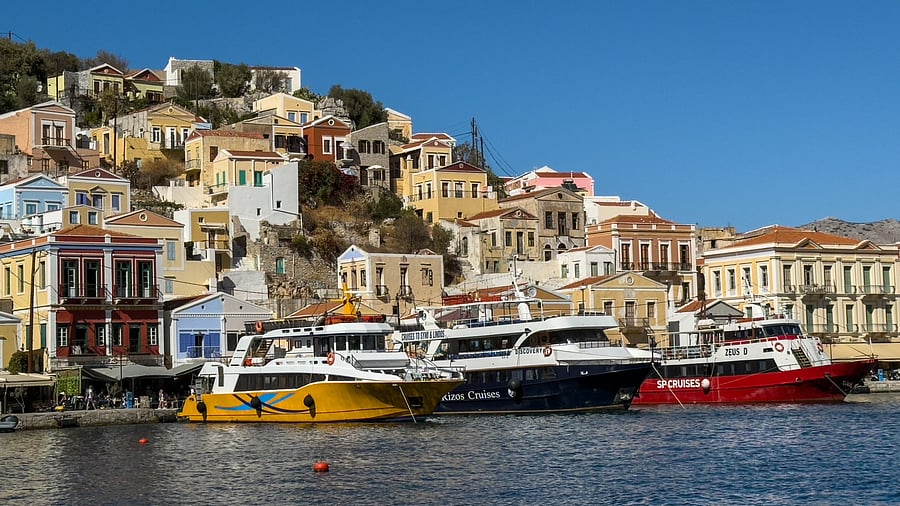
Colourful houses dot the island of Symi.
Credit: Author
It bears repetition that if you’re planning just a few adventures in the New Year, you will undoubtedly wish to make them count. If you’re ready to push your limits a bit and explore the less-trodden path, you might face some unpredictability, and confront the unknown, but you’re also likely to engage a lot more when you discover something new and vitally local.
The rustic charm of Podlasie, Poland
When I plan an initial foray into Podlasie, the draw for me is the UNESCO Bialowieza National Park, a five-star haven of biodiversity, home to the world’s largest free-roaming population of European Bison. While this experience clearly makes it to an essential travel list, the region is strewn with gems, entirely removed from mass tourism. So, after visiting the primeval forests of Bialowieza, I drive one-and-a-half hours to the town of Janow Podlaski. The town is known for its world-famous horse stud farm, in which some of the world’s finest pureblood Arabian and Anglo-Arabian horses are reared.
Nearby, the mighty Bug River flows on its 772-km route connecting Poland, Belarus and Ukraine. The Polish span of the river, 587 km long, is a sanctuary for beavers, swans, cranes and unusual species of butterflies. From the village of Zabuze, I embark upon a catamaran cruise to acquaint myself with the river
As ethereal, is a stop by the evening light at the Holy Mountain of Grabarka, a destination for pilgrims of the centuries-old Orthodox Church. Upon a hill adjoining an Orthodox Church lies a sea of crosses of all shapes, sizes and materials. Upon these crosses, are devotional symbols from rosaries to amulets.
Another special site, noteworthy for the sheer passion and craftsmanship involved in creating it, is a small castle, fondly called “The Crown of Podlasie.” Its creator Jerry Korowicki conjured up this structural confection using his own finances. The result is now a whimsical building of hand-hewn and processed stone — accompanied by features like a moat and gardens, that are open to the public and that enterprising Jerry himself guides you through.
Another Podlasie gem is the “Herbal Corner” in Koryciny. This open-air museum (with a 17th-century wooden church) and ethnographic park are where traditional architecture and museum meet botanical garden. Here, plants used for healing and the culinary arts over the ages, are cultivated across 12 hectares of land. In my time here, I wander from a pottery workshop to a herbal store and library, to a rose garden and rose café for homemade rose ice cream, to a store for handmade products, and to an inn to taste local specialities — like a carefree spirit. You can even book a stay in a traditional farmhouse if you’d like to extend what really is an engaging local experience.
Sparkling Symi in Greece
If ever I decide to retreat from big-city life, it would be to Symi, a Greek island, part of the Dodecanese islands. This island, around a one-hour ferry ride from very well-connected Rhodes, is a haiku of neoclassical homes, glorious beaches and a vibrantly alive harbour front. Sparkling Symi has an abundance of family-owned stores and artisanal studios. Most fascinating are those dedicated to sponge display and sale. I learned at the Dinos Sponge Center, that the earliest Greeks to dive for sponges hailed from Symi. At this oldest sponge shop on the island, in existence since 1939, I learned how the crew of a sponge-diving fleet taught other islanders to dive, process and trade sponge. You can now find a sponge for every need — including prized ones for face and body exfoliation.
Elsewhere, travellers strident with cardiovascular efficiency, swim in the sparkling blue-green waters of the harbour, while others walk up the hills for awe-inspiring views. Still others relax in island cafés, dining on sumptuous Greek salads and the freshest of fish, including the tiny red pan-fried shrimp, that can be eaten whole. Another gem is the Monastery of Archangel Michael Panormitis. This crucible of religious art, believed to have existed since the 15th century, is a feast of all things ornate. The interior of the chapel is plastered with wall paintings from the Byzantine period. The adjoining museum showcases icons and items of folk culture including boats related to the fishing tradition of the area.
Poetry in stone in Trier, Germany
Perfectly framed between the Moselle River and Luxembourg, is Germany’s oldest city, namely Trier. This city, now peppered with UNESCO sites, was founded by the Romans who left ample evidence of their reign amid the ruins left behind. Notable among the offerings are an amphitheatre, a section of a town wall, a river bridge, ruins of Roman baths, and the remarkably well-preserved 2nd century Porta Nigra, or Black Gate.
To admire this Gate is to do more than take its picture, but rather to appreciate the ingenuity of its construction, for this otherworldly affair is held together with nothing but iron clamps and the force of gravity. Architectural wonders from later times include some wondrous churches, for instance, the Trier Cathedral and Constantine Basilica. Also visit the Landesmuseum, home to a sprawling collection of Roman artefacts. This city is also the birthplace of Karl Marx. A university town, its centre brims with cafés. Vineyards and wineries are close at hand. While there’s never a dull moment in Trier, factor in a bit more time to explore so that you can relish, rather than rush the experience.